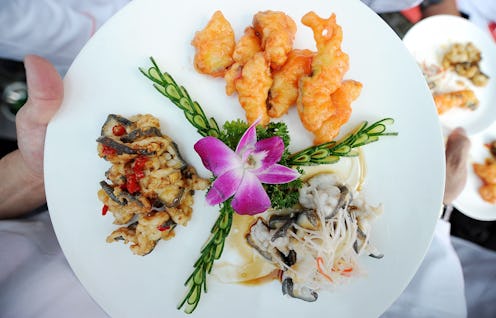Life
Bad News For Seamless Lovers
Brace yourself, my fellow Seamless lovers, for I bear grave tidings. According to a recent investigation by NBC New York, some restaurants use false identities on food delivery websites, so there's a chance your 2 a.m. curry fix is coming from — well, who knows? I think I speak for all of us when I say: Yikes.
"We take the accuracy of our restaurant listings seriously. We are partnering with New York's Department of Consumer Affairs to address the issue and remove inaccuracies," a GrubHub spokesperson told NBC after an I-Team investigation uncovered what they called a "delivery shell game." (GrubHub and Seamless merged into one entity in 2013.) According to the report, a little more than 10 percent of the top 100 most well-reviewed restaurants on Seamless and GrubHub, turned out to be ghosts — that is, they listed names or addresses that weren't registered with the city for inspection. Bustle reached out to GrubHub and Seamless for additional comment but received no response by press time.
There are several reasons a restaurant could choose to use a false identity: First, and perhaps the most intuitive, is that these restaurants could be fronts for unregulated kitchens, allowing them to operate without answering to the city's department of health regulation. In fact, New York City Consumer Affairs Commissioner Julie Menin told NBC that there's a chance some "restaurants" could be people operating from home and delivering on their own. While that might not sound like a big deal at first glance, think about the cleanliness of your own kitchen — or, if you're a total neat freak, that of your friends'. I don't know about you, but I've seen some home kitchens (especially in college) that would make a health inspector burst into tears.
Besides, if you actually want to get a home-cooked meal made by someone else, there are actually services for that: Foodie Shares is an LA-based app that many have called "the Uber of home cooking." The difference, of course, is that when you sign up for Foodie Shares, you're voluntarily ordering food cooked in a home kitchen, not being hoodwinked into doing so. And it's a difference that matters.
Restaurants may also be using the fronts as a way to keep up with each other. One restaurant owner explained to NBC that it's common practice for businesses to advertise under multiple names and phone lines, which increases their chances of receiving an order.
Although they're not legally responsible for verifying restaurant names and addresses, GrubHub and Seamless have responded well to the issue and changed their policies accordingly. "Going forward, GrubHub will take additional steps to verify the details restaurants provide. Our new process includes more checks to validate the name and location of restaurants. Should any discrepancies arise, we will take immediate action to correct information or remove inaccurate listings of restaurants on our platforms," a spokesperson for GrubHub told Lifehacker in a statement.
Of course, some (very drunk) people may actually want to eat C-grade restaurant food, for inexplicable reasons of their own. However, if you'd rather eat food that hasn't been prepared in a questionable or unknown location, verifying a restaurant's identity can be as simple as a little Googling. For instance, you can use Street View to see if there's an actual restaurant at the listed address, or simply check out your city's health department listings to see if it's received a grade; it also might be a good idea to check whether the restaurant has a website of its own, since a lack of an online presence can be something of a red flag in today's plugged-in world. Your growling stomach may demand that you throw caution to the wind and order as fast as possible, but the extra minute or two won't kill you. Hopefully.
Images: Giphy (2)
